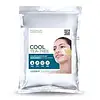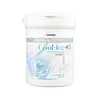What's inside
What's inside
 Key Ingredients
Key Ingredients

 Benefits
Benefits

 Concerns
Concerns

 Ingredients Side-by-side
Ingredients Side-by-side

Diatomaceous Earth
AbrasiveCI 77231
Cosmetic ColorantGlucose
HumectantAlgin
MaskingTetrapotassium Pyrophosphate
BufferingCellulose Gum
Emulsion StabilisingMaltodextrin
AbsorbentSorbitan Fatty Acid Ester
EmulsifyingLactococcus Ferment Extract
Skin ConditioningMelaleuca Alternifolia Leaf Powder 0.15%
AbrasiveAllantoin
Skin ConditioningPotassium Alginate
Emulsion StabilisingAdenosine
Skin ConditioningAloe Barbadensis Leaf Juice Powder
Skin ConditioningBetaine
HumectantUltramarines
Mentha Piperita Oil 0.1%
MaskingDiatomaceous Earth, CI 77231, Glucose, Algin, Tetrapotassium Pyrophosphate, Cellulose Gum, Maltodextrin, Sorbitan Fatty Acid Ester, Lactococcus Ferment Extract, Melaleuca Alternifolia Leaf Powder 0.15%, Allantoin, Potassium Alginate, Adenosine, Aloe Barbadensis Leaf Juice Powder, Betaine, Ultramarines, Mentha Piperita Oil 0.1%
 Reviews
Reviews

Ingredients Explained
These ingredients are found in both products.
Ingredients higher up in an ingredient list are typically present in a larger amount.
Algin is brown algae. Algae is an informal term for a group of aquatic organisms that can photosynthesize. It is estimated there are at least 30,000 types of Algae.
Algae contains antioxidants. Antioxidants help fight free-radicals. Free-radicals are molecules that may damage your skin cells, such as pollution.
Allantoin is a soothing ingredient known for its protective and moisturizingg properties. Because of this, it is often added to products with strong active ingredients.
Studies show higher concentrations of this ingredient can promote wound healing.
Though it can be derived from the comfrey plant, allantoin is produced synthetically for cosmetic products to ensure purity.
Learn more about AllantoinWe don't have a description for CI 77231 yet.
Diatomaceous Earth is an exfoliant.
Glucose is a simple sugar and is the most important source of energy in all organisms.
In skincare, glucose is used to hydrate the skin. It also acts as a prebiotic for our natural biome.
Glucose is hydrating due to its humectant property. As a humectant, glucose draws moisture from the air and from deeper levels in the skin.
Our skin contains many sugars that act as prebiotics and help strengthen our natural microbiome. Having a healthy microbiome helps protect our skin from harmful bacteria and other contaminants.
Studies show glucose may help with fading discoloration and pigmentation. This is because our skin metabolizes glucose into lactic acid. Lactic acid is an AHA that helps exfoliate the top layer of skin.
Learn more about Glucose